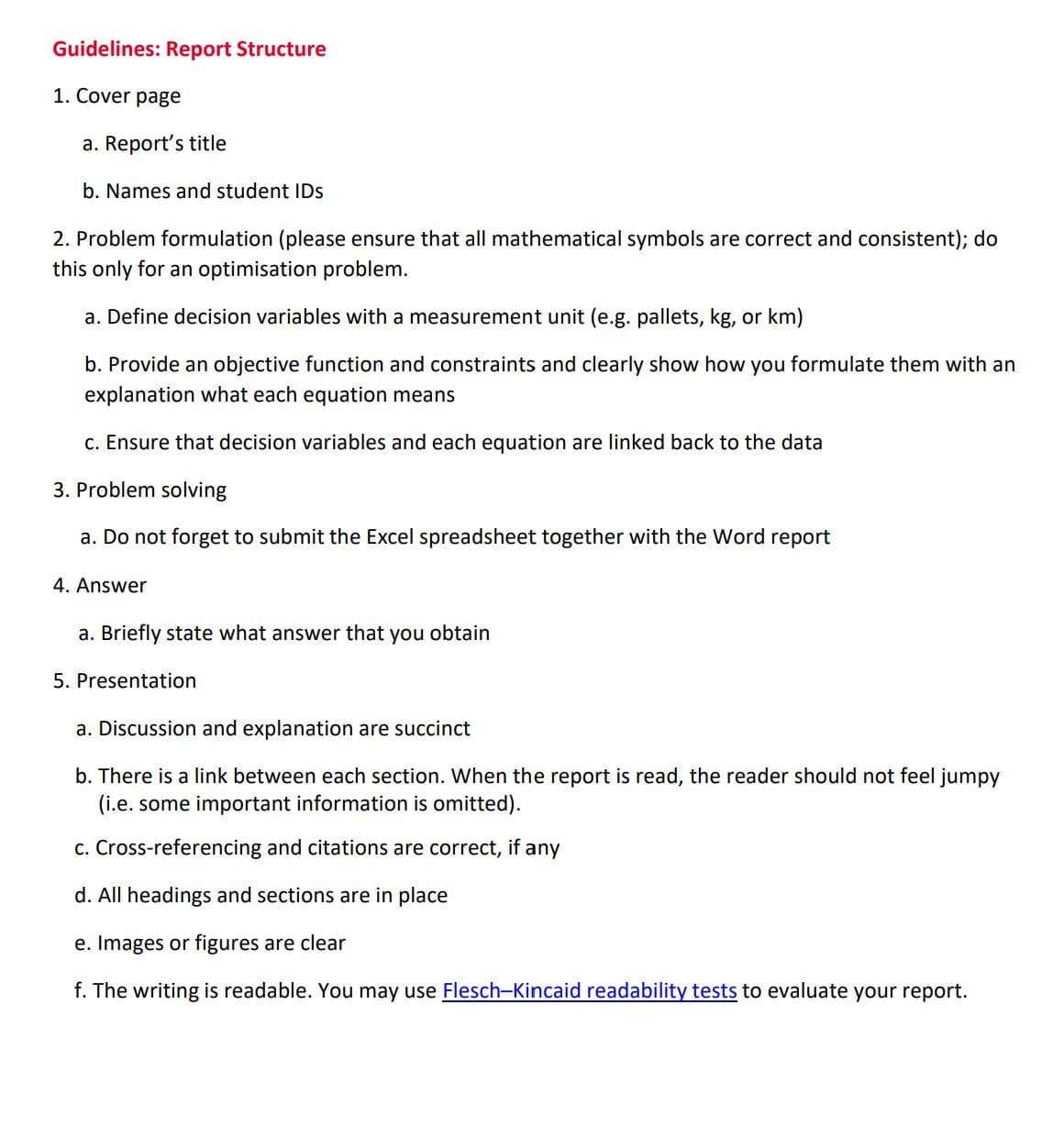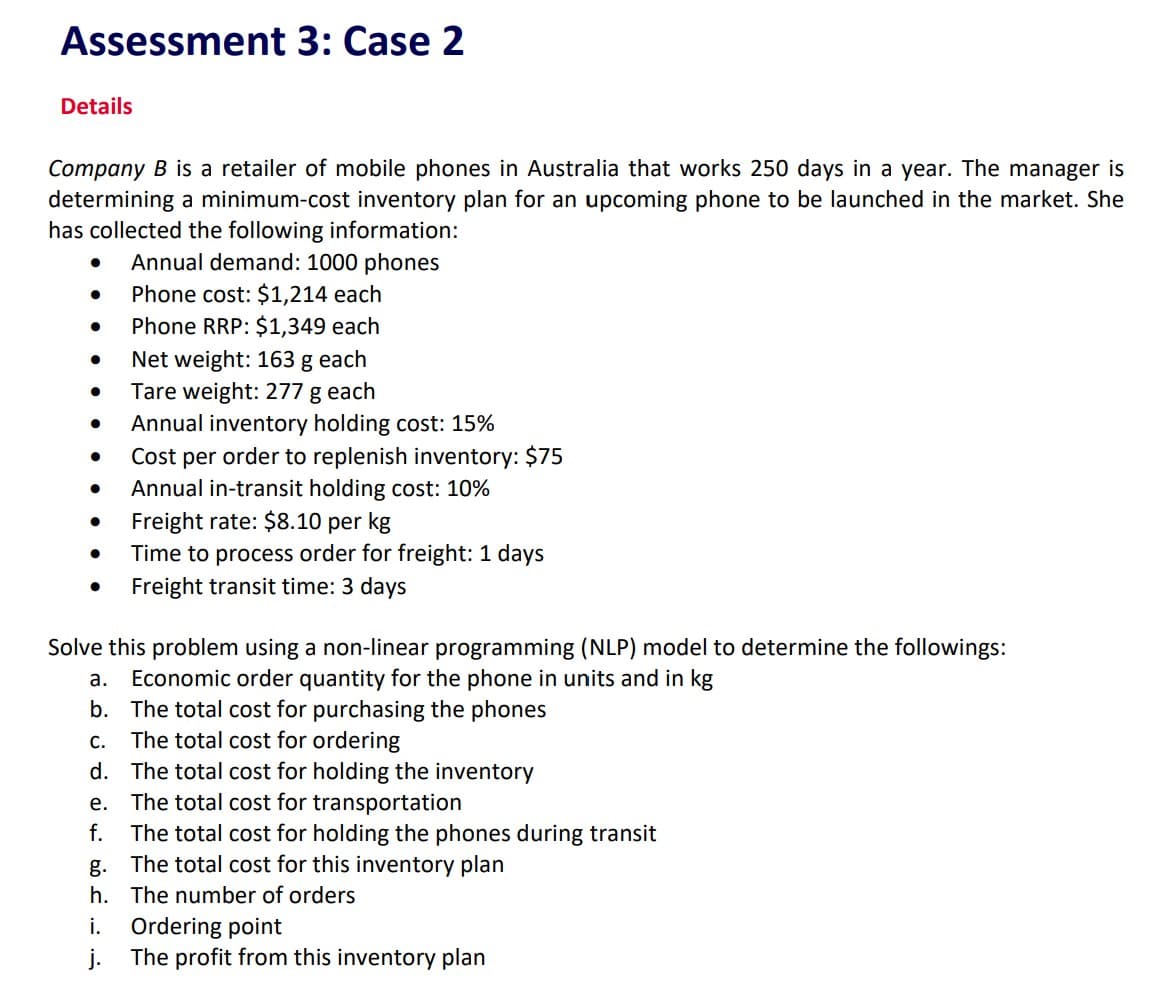Company B is a retailer of mobile phones in Australia that works 250 days in a year. The manager is determining a minimum-cost inventory plan for an upcoming phone to be launched in the market. She has collected the following information: Annual demand: 1000 phones • Phone cost: $1,214 each • Phone RRP: $1,349 each • Net weight: 163 g each • Tare weight: 277 g each • Annual inventory holding cost: 15% • Cost per order to replenish inventory: $75 • Annual in-transit holding cost: 10% • Freight rate: $8.10 per kg • Time to process order for freight: 1 days • Freight transit time: 3 days Solve this problem using a non-linear programming (NLP) model to determine the followings: a. Economic order quantity for the phone in units and in kg b. The total cost for purchasing the phones c. The total cost for ordering d. The total cost for holding the inventory e. The total cost for transportation f. The total cost for holding the phones during transit g. The total cost for this inventory plan h. The number of orders i. Ordering point j. The profit from this inventory plan
Critical Path Method
The critical path is the longest succession of tasks that has to be successfully completed to conclude a project entirely. The tasks involved in the sequence are called critical activities, as any task getting delayed will result in the whole project getting delayed. To determine the time duration of a project, the critical path has to be identified. The critical path method or CPM is used by project managers to evaluate the least amount of time required to finish each task with the least amount of delay.
Cost Analysis
The entire idea of cost of production or definition of production cost is applied corresponding or we can say that it is related to investment or money cost. Money cost or investment refers to any money expenditure which the firm or supplier or producer undertakes in purchasing or hiring factor of production or factor services.
Inventory Management
Inventory management is the process or system of handling all the goods that an organization owns. In simpler terms, inventory management deals with how a company orders, stores, and uses its goods.
Project Management
Project Management is all about management and optimum utilization of the resources in the best possible manner to develop the software as per the requirement of the client. Here the Project refers to the development of software to meet the end objective of the client by providing the required product or service within a specified Period of time and ensuring high quality. This can be done by managing all the available resources. In short, it can be defined as an application of knowledge, skills, tools, and techniques to meet the objective of the Project. It is the duty of a Project Manager to achieve the objective of the Project as per the specifications given by the client.
Company B is a retailer of mobile phones in Australia that works 250 days in a year. The manager is
determining a minimum-cost inventory plan for an upcoming phone to be launched in the market. She
has collected the following information:
Annual demand: 1000 phones
• Phone cost: $1,214 each
• Phone RRP: $1,349 each
• Net weight: 163 g each
• Tare weight: 277 g each
• Annual inventory holding cost: 15%
• Cost per order to replenish inventory: $75
• Annual in-transit holding cost: 10%
• Freight rate: $8.10 per kg
• Time to process order for freight: 1 days
• Freight transit time: 3 days
Solve this problem using a non-linear programming (NLP) model to determine the followings:
a. Economic order quantity for the phone in units and in kg
b. The total cost for purchasing the phones
c. The total cost for ordering
d. The total cost for holding the inventory
e. The total cost for transportation
f. The total cost for holding the phones during transit
g. The total cost for this inventory plan
h. The number of orders
i. Ordering point
j. The profit from this inventory plan


Trending now
This is a popular solution!
Step by step
Solved in 4 steps

From Profit = Total SP – Total CP , what does SP stand for ?





